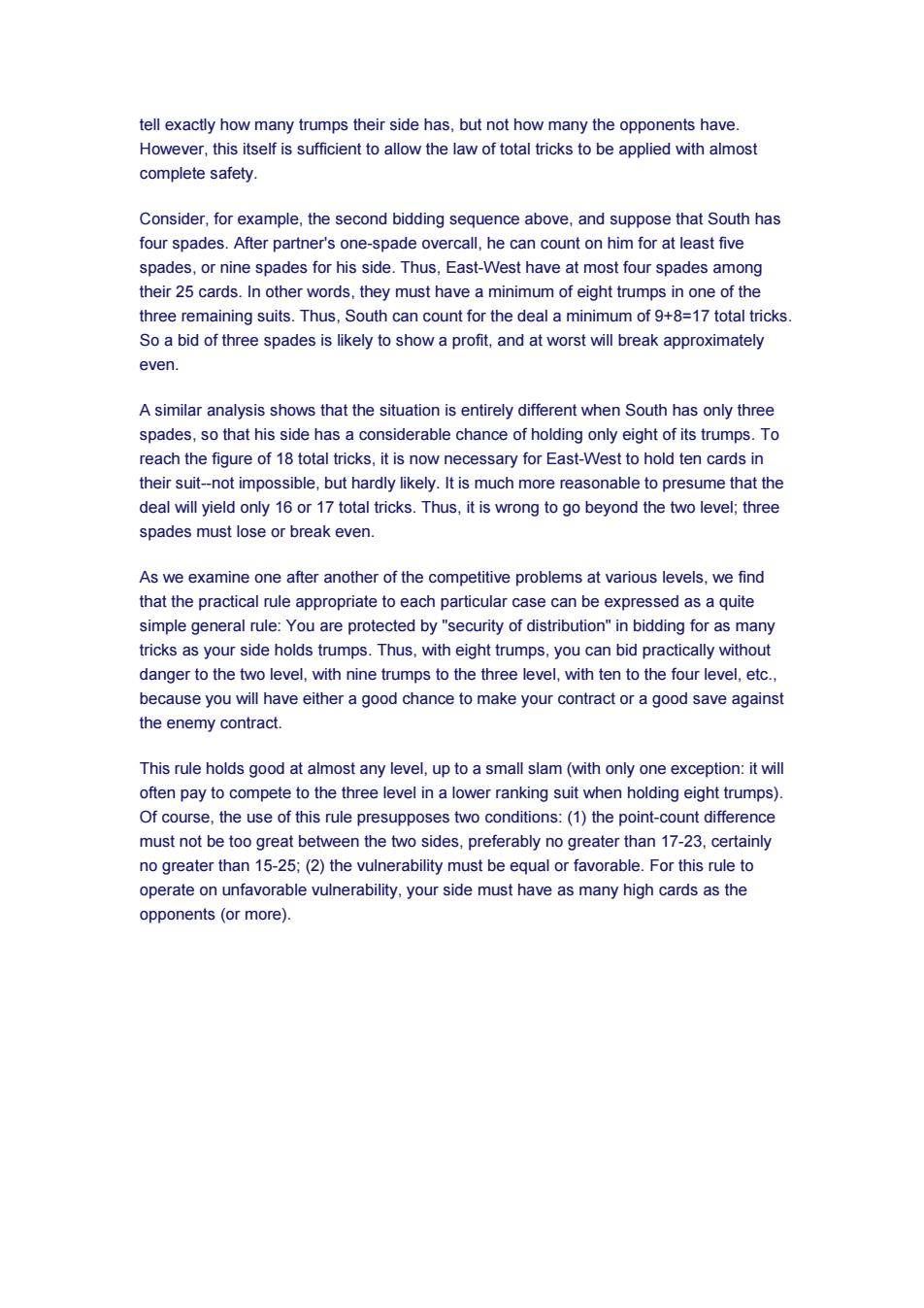正在加载图片...

tell exactly how many trumps their side has,but not how many the opponents have. However,this itself is sufficient to allow the law of total tricks to be applied with almost complete safety Consider,for example,the second bidding sequence above,and suppose that South has four spades.After partner's one-spade overcall,he can count on him for at least five spades,or nine spades for his side.Thus,East-West have at most four spades among their 25 cards.In other words,they must have a minimum of eight trumps in one of the three remaining suits.Thus,South can count for the deal a minimum of 9+8=17 total tricks. So a bid of three spades is likely to show a profit,and at worst will break approximately even. A similar analysis shows that the situation is entirely different when South has only three spades,so that his side has a considerable chance of holding only eight of its trumps.To reach the figure of 18 total tricks,it is now necessary for East-West to hold ten cards in their suit--not impossible,but hardly likely.It is much more reasonable to presume that the deal will yield only 16 or 17 total tricks.Thus,it is wrong to go beyond the two level;three spades must lose or break even As we examine one after another of the competitive problems at various levels,we find that the practical rule appropriate to each particular case can be expressed as a quite simple general rule:You are protected by "security of distribution"in bidding for as many tricks as your side holds trumps.Thus,with eight trumps,you can bid practically without danger to the two level,with nine trumps to the three level,with ten to the four level,etc., because you will have either a good chance to make your contract or a good save against the enemy contract. This rule holds good at almost any level,up to a small slam(with only one exception:it will often pay to compete to the three level in a lower ranking suit when holding eight trumps). Of course,the use of this rule presupposes two conditions:(1)the point-count difference must not be too great between the two sides,preferably no greater than 17-23,certainly no greater than 15-25;(2)the vulnerability must be equal or favorable.For this rule to operate on unfavorable vulnerability,your side must have as many high cards as the opponents(or more).tell exactly how many trumps their side has, but not how many the opponents have. However, this itself is sufficient to allow the law of total tricks to be applied with almost complete safety. Consider, for example, the second bidding sequence above, and suppose that South has four spades. After partner's one-spade overcall, he can count on him for at least five spades, or nine spades for his side. Thus, East-West have at most four spades among their 25 cards. In other words, they must have a minimum of eight trumps in one of the three remaining suits. Thus, South can count for the deal a minimum of 9+8=17 total tricks. So a bid of three spades is likely to show a profit, and at worst will break approximately even. A similar analysis shows that the situation is entirely different when South has only three spades, so that his side has a considerable chance of holding only eight of its trumps. To reach the figure of 18 total tricks, it is now necessary for East-West to hold ten cards in their suit--not impossible, but hardly likely. It is much more reasonable to presume that the deal will yield only 16 or 17 total tricks. Thus, it is wrong to go beyond the two level; three spades must lose or break even. As we examine one after another of the competitive problems at various levels, we find that the practical rule appropriate to each particular case can be expressed as a quite simple general rule: You are protected by "security of distribution" in bidding for as many tricks as your side holds trumps. Thus, with eight trumps, you can bid practically without danger to the two level, with nine trumps to the three level, with ten to the four level, etc., because you will have either a good chance to make your contract or a good save against the enemy contract. This rule holds good at almost any level, up to a small slam (with only one exception: it will often pay to compete to the three level in a lower ranking suit when holding eight trumps). Of course, the use of this rule presupposes two conditions: (1) the point-count difference must not be too great between the two sides, preferably no greater than 17-23, certainly no greater than 15-25; (2) the vulnerability must be equal or favorable. For this rule to operate on unfavorable vulnerability, your side must have as many high cards as the opponents (or more)